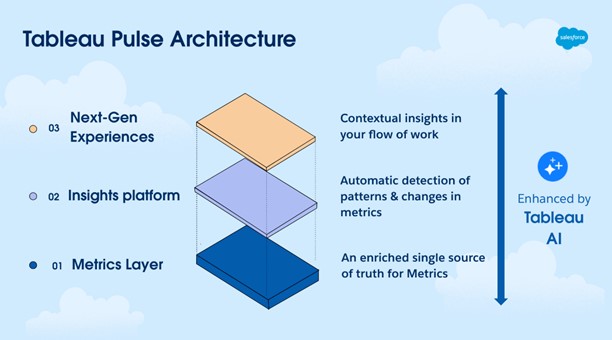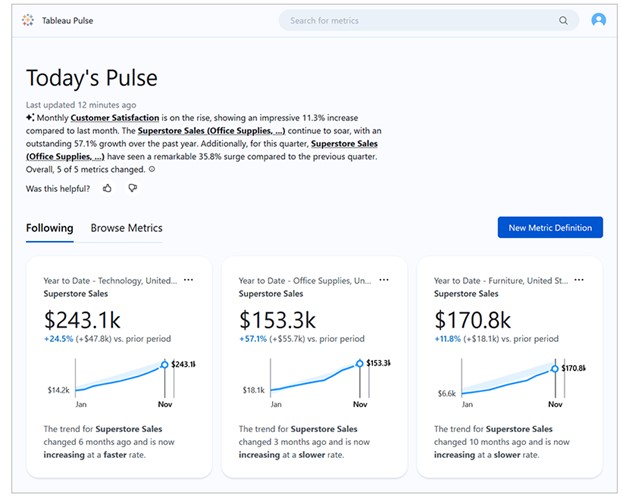Salesforce has ushered in a new era of data analysis with Tableau GPT and Tableau Pulse. These groundbreaking innovations harness generative AI, potentially transforming the landscape of analytics for good. Additionally, Salesforce Data Cloud for Tableau facilitates seamless integration of customer data, providing a unified view for faster insights. In this blog, we will explore how these developments stand not only to revolutionize data and analytics across organizational hierarchies but also empower users to become truly data driven.
Leading the Data Analytics and Visualization Race
Within the realm of data analytics and visualization, Tableau has long been a frontrunner. Leveraging its robust features and user-friendly interface, Tableau has empowered both businesses and individuals to convert intricate data into easily understandable visual representations. However, the landscape transformed significantly with the advent of Tableau GPT and Tableau Pulse.
Tableau GPT: Elevating Data Analysis to New Heights
Tableau GPT is an assistant that leverages the advanced capabilities of generative AI to simplify and democratize the process of data analysis. It is built from Einstein GPT and is designed to provide non-technical users with a quick understanding of their data without the need for dedicated data analysis resources.
Tableau GPT allows users to ask questions within the console, and the system responds with visually appealing and meaningful visualizations. This conversational approach streamlines the data exploration process, making it more accessible and efficient for all users. Tableau GPT empowers individuals across various roles to derive actionable insights from their data, whether it’s tracking sales progress, uncovering trends in commerce, or identifying service improvement opportunities.
Tableau GPT combines the power of generative AI with the intuitive interface of Tableau, allowing users to interact with their data in unprecedented ways. This innovative integration enables analysts, consumers, admins, developers, and more to access AI-powered insights and explore data through natural language prompts.
From Static Visualizations to Dynamic Dialogues
Tableau GPT transcends traditional static visualizations, allowing users to engage in dynamic, natural language dialogues with their data. This shift enables users to ask questions, seek explanations, and request predictions directly from visualizations, fostering a deeper understanding and expediting data-driven decision-making.
Fostering Collaboration
Beyond individual exploration, Tableau GPT promotes collaborative data exploration. Users can seamlessly share visualizations, encouraging real-time interaction and inclusivity. This collaborative environment enhances communication and decision-making processes, fostering a more connected approach to data analysis.
Use Cases for Tableau GPT
- Sales Leaders: Tableau GPT provides real-time visualizations for tracking sales progress and optimizing strategies.
- Commerce Leaders: Analyzing data with Tableau GPT helps understand factors affecting average order value, enabling informed decisions.
- Service Leaders: Tableau GPT monitors and optimizes customer satisfaction through dynamic visualizations, offering proactive solutions.
Tableau Pulse: Empowering Faster and Smarter Decision-Making
Beyond Tableau GPT, Tableau Pulse introduces a smarter approach to data utilization by aiding organizations in automating analysis and communicating insights in accessible, natural language. Powered by Tableau AI, it is an attempt at reimagining the data experience and making it accessible to everyone, regardless of their familiarity with data. This reimagined data experience empowers every employee with personalized and contextual insights delivered directly in their flow of work. To begin with, Tableau Pulse handles heavy lifting, guiding users from “what” to “why.” It autonomously detects and generates insights, foresees questions users might ask, and even suggests queries that may not have been considered.
Tableau Pulse brings the power and flexibility of a Metrics Layer, also known as a headless BI—to Tableau’s platform, enabling metrics and KPIs to be defined once and then used across the organization. This not only saves analysts time but ensures teams are aligning to the same trusted numbers thanks to a single source of truth.
Insights on Autopilot
An Insights platform runs on top of the Metrics Layer, which is a statistical service that automatically generates insights about the Metrics that have been defined, ranks these insights, and then summarizes them in natural language using generative AI. The service also enables users to engage with insights and dive deeper into their data through guided follow-up questions that are proactively surfaced and based on the data’s context.
Next-Gen Data Experience
Finally, Tableau Pulse also provides a Next-Gen Experiences by presenting data using intuitive, consumer-friendly metrics that are delivered directly to users in their flow of work in Slack, email, Tableau web app, etc.,
The integration of Tableau Pulse with collaboration tools like Slack and email takes decision-making to a whole new level. Users can effortlessly interact with and collaborate on insights within their familiar work environments, eliminating the need for context-switching and fostering seamless teamwork.
Generative AI enhances each layer of Tableau Pulse, making it easier for all users to discover relevant metrics, create metrics from existing content, understand insights, ask questions, conduct root cause analysis, and tie data to a real-world context.

Real-Time Data at Your Fingertips
Tableau Pulse introduces real-time data monitoring and alerting within the Tableau platform. This capability ensures users stay updated on emerging trends or anomalies, unleashing the full potential of metrics and KPIs for timely decision-making.
A Paradigm Shift in Data Visualization
The amalgamation of Tableau, GPT, and Tableau Pulse revolutionizes data visualization. The conversational interface of Tableau GPT and the streamlined data analysis of Tableau Pulse make data comprehensible to both experts and non-technical users.

Use Cases
Business Users: Tableau Pulse provides timely insights for informed decision-making, covering market trends, campaign performance, and key metrics.
Collaborative Analysis: With collaboration tools, Tableau Pulse facilitates real-time collaboration among team members, promoting a data-driven culture.
Conclusion
The introduction of Tableau GPT and Tableau Pulse signifies a revolution in data analytics. These AI-powered technologies empower users to unlock the full potential of their data, facilitating smarter decisions at an unprecedented pace. Bridging the gap between data and actionable insights, Tableau’s innovations play a pivotal role in navigating the data-driven landscape.
Tableau Pulse Beta Available Now. Click here for general FAQs. Stay tuned for the latest updates!
Note: Tableau Pulse combines metrics and insights in an all-new experience. Following the release of Tableau Pulse, Ask Data and Tableau’s legacy Metrics feature will be retired in February 2024 for Tableau Cloud and in Tableau Server version 2024.2. Like Ask Data, Tableau Pulse lets you ask questions of your data, so you can learn the how and why behind the numbers you see. Tableau Pulse also lets you create and track metrics, like the legacy Metrics feature, but Tableau Pulse metrics don’t stand alone. These metrics are the source of insights about your data.
Reference Links:











 Media Coverage
Media Coverage Press Release
Press Release
